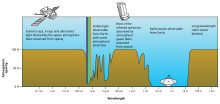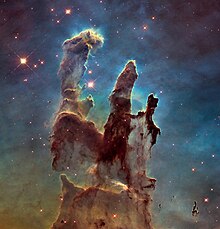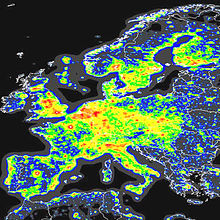
Amateur astronomy is a hobby where participants enjoy observing or imaging celestial objects in the sky using the unaided eye, binoculars, or telescopes. Even though scientific research may not be their primary goal, some amateur astronomers make contributions in doing citizen science, such as by monitoring variable stars, double stars, sunspots, or occultations of stars by the Moon or asteroids, or by discovering transient astronomical events, such as comets, galactic novae or supernovae in other galaxies.
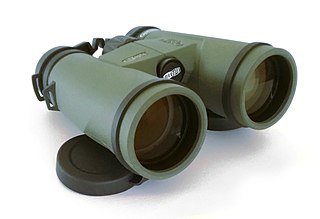
Binoculars or field glasses are two refracting telescopes mounted side-by-side and aligned to point in the same direction, allowing the viewer to use both eyes when viewing distant objects. Most binoculars are sized to be held using both hands, although sizes vary widely from opera glasses to large pedestal-mounted military models.
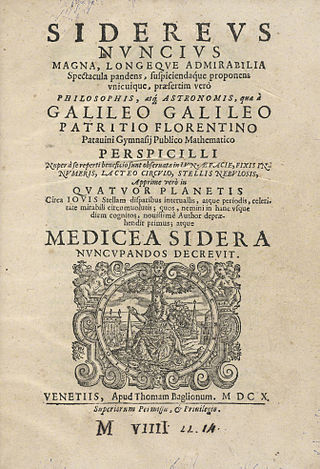
Sidereus Nuncius is a short astronomical treatise published in Neo-Latin by Galileo Galilei on March 13, 1610. It was the first published scientific work based on observations made through a telescope, and it contains the results of Galileo's early observations of the imperfect and mountainous Moon, of hundreds of stars not visible to the naked eye in the Milky Way and in certain constellations, and of the Medicean Stars that appeared to be circling Jupiter.

The history of the telescope can be traced to before the invention of the earliest known telescope, which appeared in 1608 in the Netherlands, when a patent was submitted by Hans Lippershey, an eyeglass maker. Although Lippershey did not receive his patent, news of the invention soon spread across Europe. The design of these early refracting telescopes consisted of a convex objective lens and a concave eyepiece. Galileo improved on this design the following year and applied it to astronomy. In 1611, Johannes Kepler described how a far more useful telescope could be made with a convex objective lens and a convex eyepiece lens. By 1655, astronomers such as Christiaan Huygens were building powerful but unwieldy Keplerian telescopes with compound eyepieces.

A refracting telescope is a type of optical telescope that uses a lens as its objective to form an image. The refracting telescope design was originally used in spyglasses and astronomical telescopes but is also used for long-focus camera lenses. Although large refracting telescopes were very popular in the second half of the 19th century, for most research purposes, the refracting telescope has been superseded by the reflecting telescope, which allows larger apertures. A refractor's magnification is calculated by dividing the focal length of the objective lens by that of the eyepiece.

An optical telescope is a telescope that gathers and focuses light mainly from the visible part of the electromagnetic spectrum, to create a magnified image for direct visual inspection, to make a photograph, or to collect data through electronic image sensors.

Draco is a constellation in the far northern sky. Its name is Latin for dragon. It was one of the 48 constellations listed by the 2nd century astronomer Ptolemy, and remains one of the 88 modern constellations today. The north pole of the ecliptic is in Draco. Draco is circumpolar from northern latitudes, meaning that it never sets and can be seen at any time of year.
Naked eye, also called bare eye or unaided eye, is the practice of engaging in visual perception unaided by a magnifying, light-collecting optical instrument, such as a telescope or microscope, or eye protection.

Observational astronomy is a division of astronomy that is concerned with recording data about the observable universe, in contrast with theoretical astronomy, which is mainly concerned with calculating the measurable implications of physical models. It is the practice and study of observing celestial objects with the use of telescopes and other astronomical instruments.

The Newtonian telescope, also called the Newtonian reflector or just a Newtonian, is a type of reflecting telescope invented by the English scientist Sir Isaac Newton, using a concave primary mirror and a flat diagonal secondary mirror. Newton's first reflecting telescope was completed in 1668 and is the earliest known functional reflecting telescope. The Newtonian telescope's simple design has made it very popular with amateur telescope makers.

An eyepiece, or ocular lens, is a type of lens that is attached to a variety of optical devices such as telescopes and microscopes. It is named because it is usually the lens that is closest to the eye when someone looks through an optical device to observe an object or sample. The objective lens or mirror collects light from an object or sample and brings it to focus creating an image of the object. The eyepiece is placed near the focal point of the objective to magnify this image to the eyes. The amount of magnification depends on the focal length of the eyepiece.

The night sky is the nighttime appearance of celestial objects like stars, planets, and the Moon, which are visible in a clear sky between sunset and sunrise, when the Sun is below the horizon.

A catadioptric optical system is one where refraction and reflection are combined in an optical system, usually via lenses (dioptrics) and curved mirrors (catoptrics). Catadioptric combinations are used in focusing systems such as searchlights, headlamps, early lighthouse focusing systems, optical telescopes, microscopes, and telephoto lenses. Other optical systems that use lenses and mirrors are also referred to as "catadioptric", such as surveillance catadioptric sensors.

The Maksutov is a catadioptric telescope design that combines a spherical mirror with a weakly negative meniscus lens in a design that takes advantage of all the surfaces being nearly "spherically symmetrical". The negative lens is usually full diameter and placed at the entrance pupil of the telescope. The design corrects the problems of off-axis aberrations such as coma found in reflecting telescopes while also correcting chromatic aberration. It was patented in 1941 by Soviet optician Dmitri Dmitrievich Maksutov. Maksutov based his design on the idea behind the Schmidt camera of using the spherical errors of a negative lens to correct the opposite errors in a spherical primary mirror. The design is most commonly seen in a Cassegrain variation, with an integrated secondary, that can use all-spherical elements, thereby simplifying fabrication. Maksutov telescopes have been sold on the amateur market since the 1950s.

A finderscope is an accessory sighting device used in astronomy and stargazing, typically a small auxiliary refracting telescope/monocular mounted parallelly on a larger astronomical telescope along the same line of sight. The finderscope usually has a much smaller magnification than the main telescope, thus providing a larger field of view, useful for manually pointing the main telescope into a roughly correct direction that can easily place a desired astronomical object in view when zooming in. Some finderscopes have sophisticated reticles to more accurately aim the main telescope and/or even perform stadiometric measurements.

A telescope is a device used to observe distant objects by their emission, absorption, or reflection of electromagnetic radiation. Originally it was an optical instrument using lenses, curved mirrors, or a combination of both to observe distant objects – an optical telescope. Nowadays, the word "telescope" is defined as wide range of instruments capable of detecting different regions of the electromagnetic spectrum, and in some cases other types of detectors.

The Moon is the largest natural satellite of and the closest major astronomical object to Earth. The Moon may be observed by using a variety of optical instruments, ranging from the naked eye to large telescopes. The Moon is the only celestial body upon which surface features can be discerned with the unaided eyes of most people.

Gemini is one of the constellations of the zodiac and is located in the northern celestial hemisphere. It was one of the 48 constellations described by the 2nd century AD astronomer Ptolemy, and it remains one of the 88 modern constellations today. Its name is Latin for twins, and it is associated with the twins Castor and Pollux in Greek mythology. Its old astronomical symbol is (♊︎).
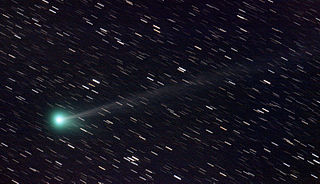
C/2009 R1 (McNaught), one of more than fifty comets known as Comet McNaught, is a non-periodic comet discovered by British-Australian astronomer Robert H. McNaught on September 9, 2009, using the Uppsala Southern Schmidt Telescope at Siding Spring Observatory in New South Wales, Australia. The discovery was confirmed the same day at the Optical Ground Station telescope at Tenerife. After the discovery, earlier images of the comet were found from July 20, August 1, and August 18, 2009. It is believed C/2009 R1 will leave the Solar System permanently.

An astronomical filter is a telescope accessory consisting of an optical filter used by amateur astronomers to simply improve the details and contrast of celestial objects, either for viewing or for photography. Research astronomers, on the other hand, use various band-pass filters for photometry on telescopes, in order to obtain measurements which reveal objects' astrophysical properties, such as stellar classification and placement of a celestial body on its Wien curve.
